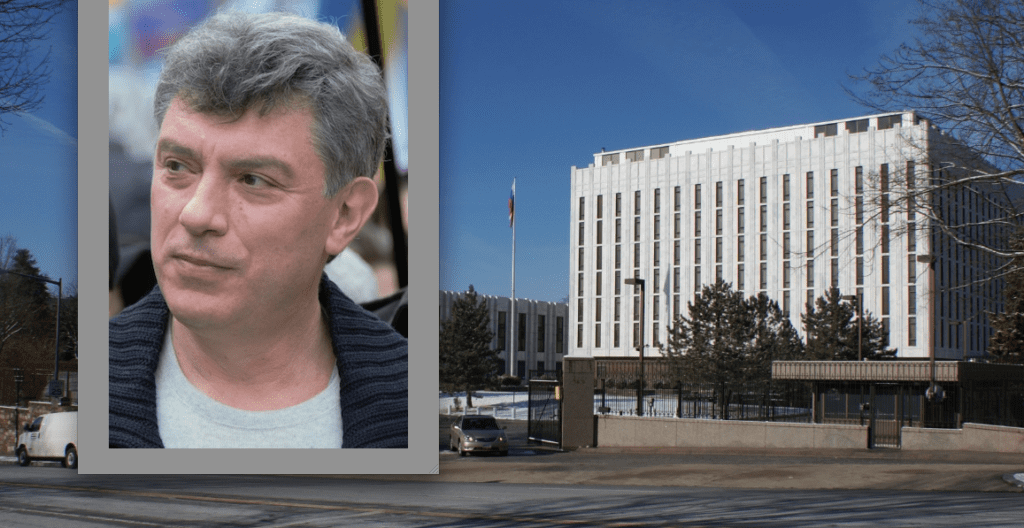D.C.’s Newest Place Name: Boris Nemtsov Plaza
By • January 16, 2018 0 1598

What’s in a name? In Washington, D.C., the places that people pass by become ingrained in our memory. Sometimes missing, though, are the details behind the naming of such places.
Last week, the District Council unanimously approved the renaming of a portion of Wisconsin Avenue directly in front of the Russian Embassy, just north of Georgetown. The address for the embassy, formerly 2650 Wisconsin Ave. NW, is now 1 Boris Nemtsov Plaza.
Fatally shot near the Kremlin on Feb. 27, 2015, Nemtsov was the former deputy prime minister, a pro-democracy leader and critic of Vladimir Putin. Many questions remain about this crime.
The embassy holds a spot in spy folklore. In 1985, triple agent Vitaly Yurchenko was under U.S. guard. The group stopped at Au Pied Cochon restaurant, now an &pizza eatery, on Wisconsin Avenue. Yurchenko took a bathroom break and used it to escape, supposedly by taking a Metro bus up the hill to the embassy.
There is another place in D.C. where Americans switched addresses on their Russian friends. In the 1980s, Congress renamed a portion of 16th Street, now the site of the Russian ambassador’s residence, Sakharov Plaza after Soviet nuclear physicist Andrei Sakharov, who evolved into a dissident and disarmament and human-rights activist.
There are many other notable persons who have left their historical mark in Washington, D.C. — itself named after the first president of the United States — with places named after them. The following are just a few examples.
L’Enfant Plaza
In D.C.’s smallest quadrant, Southwest, L’Enfant Plaza honors Pierre Charles L’Enfant, who contributed in significant ways to the United States and to Washington, D.C. L’Enfant emigrated from France and volunteered in 1776 to be part of the Continental Army during the Revolutionary War. His plans for making the city a beautiful place to be were generally disregarded while he was alive. L’Enfant, however, continually insisted on his city plan’s merits until his death in 1825. Reviewed later in the century, his ideas were finally received with favor. In L’Enfant’s plan for the city, he wanted to include wide avenues that were lined with trees, alongside important landmarks. He also found it important to respect the natural contours of the land while doing city planning.
Across the Potomac River, a monument, under the direction of the D.C. commissioners, marks the grave of L’Enfant, whose remains were moved from Digges Farm in Prince George’s County to Arlington National Cemetery. It is on the hill in front of the Custis-Lee Mansion that overlooks the federal city.
McPherson Square
In the business district on K Street, McPherson Square is named after the United States Army Maj. Gen. James B. McPherson, who was killed in the Battle of Atlanta in 1864. He was known an an exceptional military man, having graduated first in his class at the United State Military Academy at West Point. McPherson and Gen. Ulysses S. Grant worked closely together. When McPherson was killed, Grant felt a profound sense of loss, as did Gen. William Tecumseh Sherman and even Gen. John Bell Hood, the latter of whom fought on the Confederate side.
McPherson Square and the Metro station of the same name are named after this honored military figure. With its equestrian statue, McPherson Square is one of many Civil War spots in Washington. In Atlanta, there is a McPherson Monument as well, with the stated purpose being to remind people to remember the Civil War.
Anna J. Cooper Circle
At 3rd and T Streets NW in LeDroit Park, the less well-known Anna J. Cooper Circle is a tribute to a woman born into slavery in 1858 in Raleigh, North Carolina. After the Civil War, she got an education at a school for former slaves. Upon a failed marriage, she decided to pursue higher education — going to Oberlin College, where she earned bachelor’s and master’s degrees — and later moved to Washington, D.C., where she taught at Washington Colored High School. Cooper had her first book published, “A Voice from the South,” in 1892. She also taught similar classes at the Young Women’s Christian Association, but for African Americans, who weren’t allowed in the YWCAs where white women went. (In addition, there is an Anna Julia Cooper Center at Wake Forest University.)
It seems that there’s a place for just about anyone in the nation’s capital, if you know just where to look.

